How To Increase Ram Of Arduino
Arduino Memory Guide
Learn about the congenital-in memory blocks of Arduino® boards in this article.
A microcontroller unit (too known every bit a MCU) is an integrated circuit (IC), typically used to perform specific applications or tasks. Unremarkably, this type of IC gathers data or data from its surroundings, process it, and generates specific outputs according to the gathered information. Microcontrollers today are everywhere; they are an essential role of mod embedded systems that can exist found practically everywhere in our world, from smartwatches to electrical vehicles; they are even on the Martian surface correct now.
One essential part of a microcontroller is its memory; memory stores data temporarily or permanently in microcontrollers, and tin exist used for several purposes. In this article, we volition explore memory organization in microcontrollers, focusing on those nowadays in Arduino® boards. We will also explore several ways to manage, measure, and optimize memory usage in Arduino-based systems are discussed in the article.
What is Memory?
Retentivity blocks are essential parts of modern embedded systems, especially microcontroller-based ones. Memory blocks are semiconductor devices that shop and retrieve information or information; a microcontroller key processing unit (CPU) uses and processes information stored in memory blocks to perform specific tasks.
As shown in the image below, memory blocks in microcontrollers are usually described as arrays. Retention arrays are divided into cells that tin shop data and be accessed using a unique identifier representing its address or position relative to the memory assortment. Information in memory cells is stored using binary digits (bits), normally organized in bytes (8-$.25); it tin also be retrieved later by the MCU or other components of a microcontroller-based organisation.
Retentivity in computing systems can exist volatile or non-volatile. Volatile retentiveness is a temporary memory, this ways that information is stored while the system is running, but it is lost forever when the organization is turned off. Non-volatile retentiveness is permanent memory; data is not lost even if the organisation is turned off.
Memory Architectures 101
Computer architecture is a vast topic; we will focus on a general motion picture that will let us empathize how memory is organized in the microcontrollers used in Arduino® boards.
In the early days of calculating, two estimator architectures, i.e., the system of the components within a calculating system, emerged: von Neumann and Harvard.
Von Neumann Architecture
The von Neumann architecture, named later the mathematician, physicist, and computer scientist John von Neumann, was showtime introduced in the mid-'40s; information technology is besides known as the Princeton compages. This architecture stores program information and instructions in the same memory unit.

Both are accessed past the CPU using the same communications bus, as shown below. Von Neumann's architecture is fundamental since about all digital computers design have been based on this compages.
Harvard Architecture
The Harvard architecture, named after the Harvard Mark I relay-based computer, was showtime introduced in the mid-'40s. This architecture'due south master characteristic is that it uses two separate memory units, one for storing program instructions and one for storing programme data. Both memory units in the Harvard compages are accessed by the CPU using different communication buses.
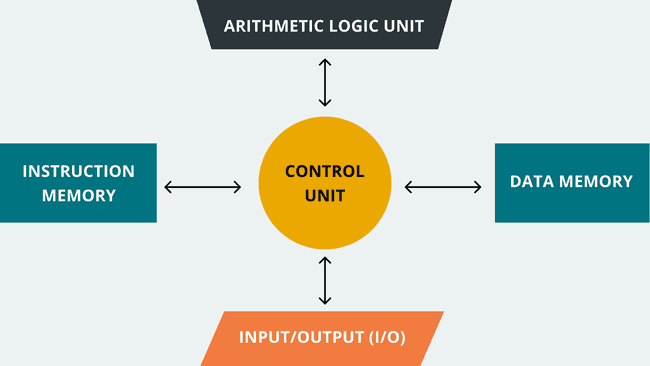
Modern Architectures: Hybrids
Modern computing systems use hybrid architectures models that maximize functioning using the best of both worlds, the von Neumann and the Harvard models.
Microcontrollers are usually used in embedded applications. They must perform defined tasks reliably and efficiently, with low or constrained resources; this is why the Harvard architecture model is mainly used in microcontrollers: microcontrollers have a small program and data memory that needs to be accessed simultaneously. However, Harvard compages is not always used in microcontrollers; some microcontroller families use hybrid or Von Neumann architecture models.
Arduino® Boards Architectures
Arduino® boards are mainly based on 2 families of microcontrollers: AVR® and ARM®. While AVR® family unit microcontrollers are based on the Harvard architecture model, ARM® family microcontrollers tin be based on either von Neuman or Harvard architectures models. The following table summarizes Arduino boards microcontrollers architectures:
| Board | Microcontroller | Family | Compages |
|---|---|---|---|
| UNO Mini | ATmega328P | AVR | Harvard |
| UNO Rev3 | ATmega328P | AVR | Harvard |
| UNO WiFi Rev2 | ATmega4809 | AVR | Harvard |
| UNO Rev3 SMD | ATmega328P | AVR | Harvard |
| Leonardo | ATmega32u4 | AVR | Harvard |
| Mega 2560 Rev3 | ATmega2560 | AVR | Harvard |
| Micro | ATmega32u4 | AVR | Harvard |
| Cypher | ATSAMD21G18 | ARM Cortex M0+ | Von Neumann |
| Portenta H7 | STM32H747 | ARM Cortex M4/M7 | Harvard |
| Nicla Sense ME | nRF52832 | ARM Cortex M4 | Harvard |
| Nano RP2040 Connect | RP2040 | ARM Cortex M0+ | Von Neumann |
| MKR Fox 1200 | ATSAMD21G18 | ARM Cortex M0+ | Von Neumann |
| MKR NB 1500 | ATSAMD21G18 | ARM Cortex M0+ | Von Neumann |
| MKR Vidor 4000 | ATSAMD21G18 | ARM Cortex M0+ | Von Neumann |
| MKR WiFi 1010 | ATSAMD21G18 | ARM Cortex M0+ | Von Neumann |
| MKR Zero | ATSAMD21G18 | ARM Cortex M0+ | Von Neumann |
| MKR1000 WIFI | ATSAMW25H18 | ARM Cortex M0+ | Von Neumann |
| MKR WAN 1300 | ATSAMD21G18 | ARM Cortex M0+ | Von Neumann |
| MKR WAN 1310 | ATSAMD21G18 | ARM Cortex M0+ | Von Neumann |
| Nano | ATmega328P | AVR | Harvard |
| Nano Every | ATmega4809 | AVR | Harvard |
| Nano 33 IoT | ATSAMD21G18 | ARM Cortex M0+ | Von Neumann |
| Nano 33 BLE | nRF52840 | ARM Cortex M4 | Harvard |
| Nano 33 BLE Sense | nRF52840 | ARM Cortex M4 | Harvard |
Retentivity Types
All the unlike memory units inside a microcontroller can be divided into ii main types: RAM and ROM. RAM (from Random-Admission Retention) in microcontroller-based systems is a volatile retentivity used to store temporary data such as the system's firmware variables. ROM (from Read-Merely Retentiveness) in microcontroller-based systems is non-volatile memory used to store permanent data such equally the organization's firmware.
RAM and ROM in microcontroller-based systems are organized into three master categories:
- Wink
- RAM
- EEPROM
Flash
Flash retentivity in microcontroller-based systems is part of its ROM. The flash retention is where the organisation'due south firmware is stored to be executed. For instance, think of the famous
Blink . ino sketch, when we compile this sketch, we create a binary file that is later stored in the wink retention of an Arduino board. The sketch is so executed when the board is powered on.
RAM
RAM in microcontroller-based systems is where the arrangement's temporary data or run-fourth dimension data is stored; for case, the variables created by functions of a program. RAM in microcontrollers usually is SRAM; this is a type of RAM that uses a flip-flop to shop one bit of data. In that location is also another type of RAM that can be found in microcontrollers: DRAM.
EEPROM
In microcontroller-based systems, Erasable Programmable Read-Only Memory, or EEPROM, is as well part of its ROM; actually, Wink memory is a blazon of EEPROM. The principal deviation betwixt Flash retentivity and EEPROM is how they are managed; EEPROM can be managed at the byte level (write or erased) while Wink tin can be managed at the block level.
Arduino® Boards Memory Resource allotment
As stated before, Arduino® boards are mainly based on two families of microcontrollers, AVR® and ARM®; information technology is important to know that memory allotment differs in both architectures. In Harvard-based AVR architecture, retention is organized as shown in the image below:
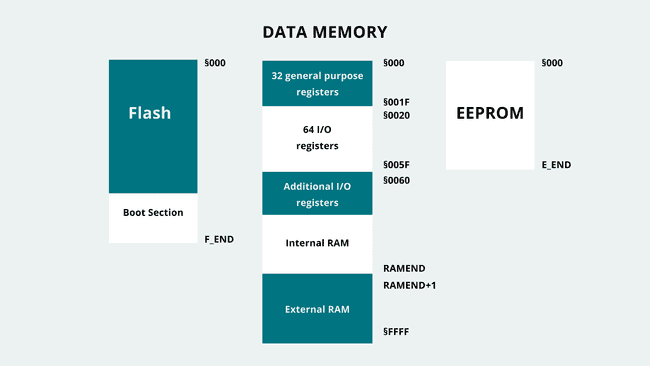
Important to mention about AVR-based Arduino boards is how their SRAM is organized into different sections:
-
Text -
Information -
BSS -
Stack -
Heap
The
text section contains instructions loaded into the flash memory;
data department contains variables initialized in the sketch,
BSS section contains uninitialized data,
stack department stores information of functions and interrupts, and
heap section stores variables created during run time.
In hybrid ARM architectures, a and then chosen memory map is implemented, with a different accost map configuration of 32-chip, 36-bit, and 40-flake that depends on the requirement of System On a Chip (SoC) accost space with extra DRAM. The Memory Map grants interface with SoC design, while having nearly organization control on a high level coding. Retention access instructions tin can be used on loftier level code to manage interrupt modules and built-in peripherals. All of this controlled past Memory Management Unit (MMU).
The retention resource is handled by the MMU. The primary role of the MMU is to enable the processor to run multiple tasks independently in its own virtual memory space; the MMU then uses translation tables to establish a span betwixt the virtual and the physical memory addresses. Virtual Address is managed via software with memory instructions, and Physical accost is the retentivity organization that is controlled depending on the Translation Table input given by the Virtual Address.
An case of how memory is organized in ARM-based microcontrollers, well-nigh and physically, is shown in the prototype below:
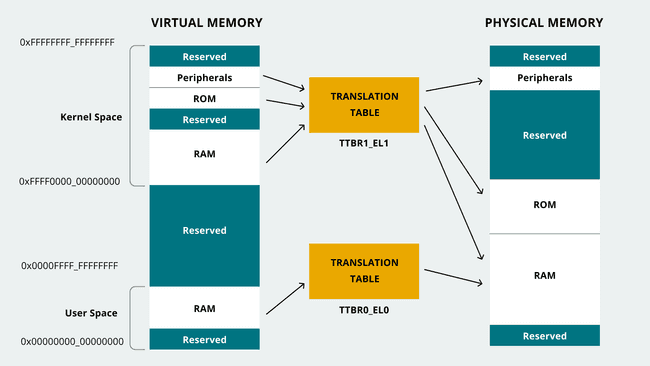
The ARM-based microcontroller's memory is organized into the following sections within the address type mentioned previously:
-
Virtual address:
-
Kernel code and data -
Application code and information
-
-
Physical address:
-
ROM -
RAM -
Flash -
Peripherals
-
The following table summarizes a specific Arduino® board's memory allocation:
| Board | Microcontroller | Family unit | Architecture | Flash | SRAM | EEPROM |
|---|---|---|---|---|---|---|
| UNO Mini | ATmega328P | AVR | Harvard | 32kB | 2kB | 1kB |
| UNO Rev3 | ATmega328P | AVR | Harvard | 32kB | 2kB | 1kB |
| UNO WiFi Rev2 | ATmega4809 | AVR | Harvard | 48kB | 6kB | 256B |
| UNO Rev3 SMD | ATmega328P | AVR | Harvard | 32kB | 2kB | 1kB |
| Leonardo | ATmega32u4 | AVR | Harvard | 32kB | 2.5kB | 1kB |
| Mega 2560 Rev3 | ATmega2560 | AVR | Harvard | 256kB | 8kB | 4kB |
| Micro | ATmega32u4 | AVR | Harvard | 32kB | 2.5kB | 1kB |
| Zero | ATSAMD21G18 | ARM Cortex M0+ | Von Neumann | 256kB | 32kB | - |
| Portenta H7 (basic configuration) | STM32H747 | ARM Cortex M4/M7 | Harvard | 16MB | 8MB | - |
| Nicla Sense ME | nRF52832 | ARM Cortex M4 | Harvard | 512kB | 64kB | - |
| Nano RP2040 Connect | RP2040 | ARM Cortex M0+ | Von Neumann | - | 264kB | - |
| MKR Flim-flam 1200 | ATSAMD21G18 | ARM Cortex M0+ | Von Neumann | 256kB | 32kB | - |
| MKR NB 1500 | ATSAMD21G18 | ARM Cortex M0+ | Von Neumann | 256kB | 32kB | - |
| MKR Vidor 4000 | ATSAMD21G18 | ARM Cortex M0+ | Von Neumann | 256kB | 32kB | - |
| MKR WiFi 1010 | ATSAMD21G18 | ARM Cortex M0+ | Von Neumann | 256kB | 32kB | - |
| MKR Zero | ATSAMD21G18 | ARM Cortex M0+ | Von Neumann | 256kB | 32kB | - |
| MKR1000 WIFI | ATSAMW25H18 | ARM Cortex M0+ | Von Neumann | 256kB | 32kB | - |
| MKR WAN 1300 | ATSAMD21G18 | ARM Cortex M0+ | Von Neumann | 256kB | 32kB | - |
| MKR WAN 1310 | ATSAMD21G18 | ARM Cortex M0+ | Von Neumann | 256kB | 32kB | - |
| Nano | ATmega328P | AVR | Harvard | 32kB | 2kB | 1kB |
| Nano Every | ATmega4809 | AVR | Harvard | 48kB | 6kB | 256B |
| Nano 33 IoT | ATSAMD21G18 | ARM Cortex M0+ | Von Neumann | 256kB | 32kB | - |
| Nano 33 BLE | nRF52840 | ARM Cortex M4 | Harvard | 1MB | 256kB | - |
| Nano 33 BLE Sense | nRF52840 | ARM Cortex M4 | Harvard | 1MB | 256kB | - |
Pro hardware SDRAM and Flash memory are highly customizable in volumes. Check out the Pro site for more information.
Measuring Memory Usage in Arduino® Boards
Memory usage statistics assistance comprehend the insight of resources management affected by the designed code structure. Memory load demand is one statistic that volition give you lot an insight into how efficient the code is design|ed. It is a crucial evolution consideration element because the resources are finite inside a microcontroller-based system; software should e'er perform without reaching maximum load chapters to avoid problems or bug. Memory load could be observed either as available RAM at disposal for specific tasks or flash storage remaining chapters for required headroom.
To avoid run-fourth dimension problems, microcontroller-based systems should always run without reaching their maximum retentiveness chapters.
Let usa talk more well-nigh retentivity usage measurement in Arduino® boards.
Wink Memory Measurement
Flash memory on Arduino® boards tin be measured with the assist of the Arduino IDE. As stated before, Wink memory is where the awarding code is stored; the Arduino IDE reports Wink memory usage through its compiler output console to let developers know how much Wink memory resource are being used.
For case, the IDE's compiler output console an AVR-based Arduino® board, the UNO, is shown in the image below:
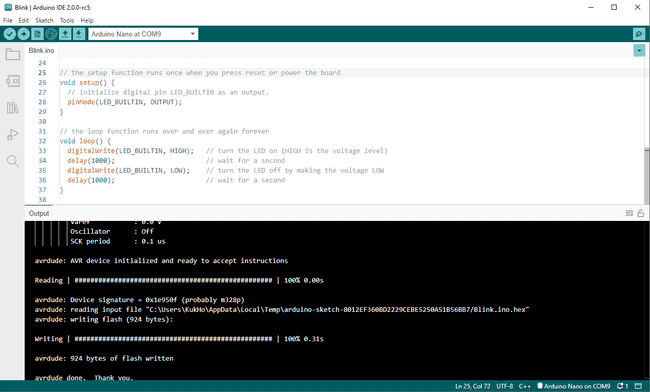
The IDE's compiler output console log for an ARM-based Arduino® board, the MKR WAN 1310, is shown in the paradigm below:
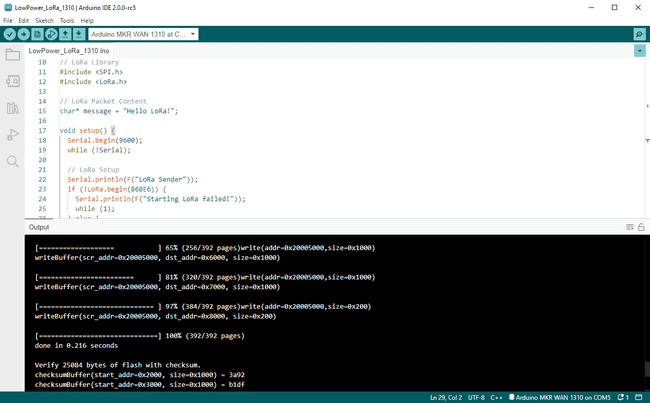
The IDE'south compiler output panel log for another ARM-based Arduino®, the Portenta H7, is shown in the image below:
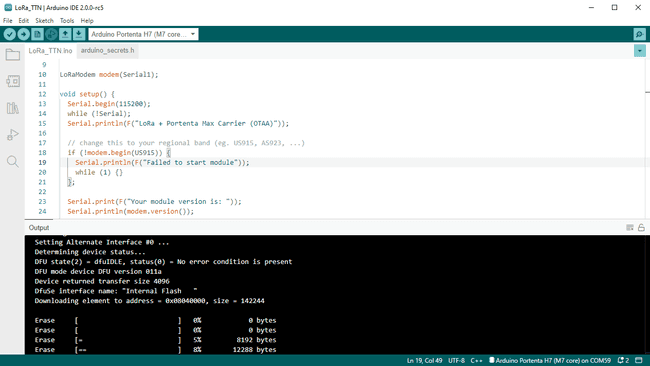
Notice that the compiler's output changes depending on if the board is AVR-based or ARM-based.
SRAM Retention Measurement
Sometimes, at that place are situations where fifty-fifty when code is compiled and uploaded successfully by the IDE into a board, information technology suffers from sudden halts. These problems are likely due to memory resource-hogging or insufficient retentiveness to allocate. It is necessary to understand which lawmaking sector the memory demand is going across the available resources to solve this. The post-obit case code tin be used to measure SRAM usage in AVR-based Arduino® boards:
one void display_freeram ( ) {
2 Serial . impress ( F ( "- SRAM left: " ) ) ;
3 Serial . println ( freeRam ( ) ) ;
4 }
v
6 int freeRam ( ) {
vii extern int __heap_start , * __brkval ;
8 int v ;
9 return ( int ) & v - ( __brkval == 0
10 ? ( int ) & __heap_start : ( int ) __brkval ) ;
eleven }
Remember that the
heap department is where variables created during the run fourth dimension are stored. In the lawmaking,
__heap_start and
__brkval are as post-obit:
-
: the beginning of the__heap_start
section.heap -
: the last retention address pointer used past the__brkval
.heap
The following example code can exist used to measure SRAM usage in ARM-based Arduino® boards:
one extern "C" char * sbrk ( int incr ) ;
2
3 void display_freeram ( ) {
4 Serial . print ( F ( "- SRAM left: " ) ) ;
v Serial . println ( freeRam ( ) ) ;
6 }
7
8 int freeRam ( ) {
nine char pinnacle ;
10 return & top - reinterpret_cast < char * > ( sbrk ( 0 ) ) ;
xi }
The code to a higher place is taken from Michael P. Flaga'due south library Arduino-MemoryFree.
EEPROM Memory Measurement
EEPROM memory direction tin can be done easily using native libraries already installed into the Arduino IDE. The
EEPROM library can be used to read, write and erase the EEPROM retentiveness. The following code shows how a byte of data can be stored in the EEPROM memory and then read using the
write and
read functions:
ane # include <EEPROM.h>
2
3 void setup ( ) {
four }
five
6 void loop {
7 // Write information into an specific address of the EEPROM memory
8 EEPROM . write ( address , value ) ;
9
10 // Read data of an specific address of the EEPROM memory
11 EEPROM . read ( address ) ;
12 }
Also, it is possible to clear the entire EEPROM retention by setting it to 0, every bit shown in the code below:
1 # include <EEPROM.h>
2
3 void setup ( ) {
4 }
5
6 void loop {
seven for ( int i = 0 ; i < EEPROM . length ( ) ; i ++ ) {
viii // Articulate EEPROM memory
ix EEPROM . write ( i , 0 ) ;
10
eleven }
For more information on how to manage the EEPROM memory, you can refer to this guide.
Optimizing Retention Usage in Arduino-based Systems
Knowing how code uses memory resources of a organisation is just the start recommended task in the development process; a whole different task is optimizing memory usage. As the term development may infer, the requirements may alter or be adapted depending on external factors such as reduced device capacity due to the unavailability of the components. Thus the code architecture may crave optimization to run on the reduced limited memory resource.
The memory usage optimization process likewise implies reduced computational complexities, trimming downward extra time required to process tasks while using fewer retention resources to do the same tasks. The memory usage optimization process may assistance the overall lawmaking optimization process, equally it volition handle how the memory is managed more suitably by requiring intelligent algorithms evolution.
Permit u.s. talk about some memory usage optimization techniques.
Wink Memory Optimization
Flash memory optimization is the most likely straightforward optimization possible source. Wink retention is where the capacity used by compiled code can be significantly reduced past considering some details.
Disassemble Unused Sources
Detaching new sources includes unused libraries and code residues. Code residues can exist equanimous of no-longer-used functions and floating variables that take upward the unnecessary space in memory. This will vastly improve the compiled code size and brand a more clear compilation process.
Modular Tasks
Modular tasks mean functions that wrap lawmaking that will be used repetitively or continuously by receiving unlike parameters. Information technology is a nifty mode to maintain make clean lawmaking structure and performance while reducing the memory space required for additional tasks that might need to be implemented.
This leads to a compact lawmaking construction, which is much easier to sympathize when debugging is required and demands the developer consider computing complexity when designing the code structure or such a specific algorithm.
SRAM Memory Optimization
SRAM retention is probably the most important retentiveness unit of measurement inside a microcontroller-based system; optimizing the SRAM usage is essential for designing reliable microcontroller-based systems. SRAM shortages are usually the most common retentivity problems found; SRAM optimization can help in reducing this type of outcome.
The platonic style to utilize the Print Line command is to utilise the
F ( ) String Wrapper effectually the literals. See the example below:
Cord Wrapper
Series . impress ( ) or
Series . println ( ) instructions uses SRAM space, which can be convenient merely non desirable. The ideal fashion to use a
Serial . impress ( ) or
Serial . println ( ) instruction is with the use of the
String wrapper around the literals. For example: F ( )
one Serial . println ( F ( "Something" ) ) ;
Wrapping the Cord
Something with the
F ( ) wrapper will move the Strings to Wink retention only rather than to use SRAM space as well. Using the
F ( ) wrapper can be observed as offloading such data to Flash retention instead of SRAM. Flash retention is much more than spacious than SRAM, so it is amend to use Flash retentiveness space than SRAM, which will utilise
heap section. This does not hateful that memory space volition always exist available, as Flash memory does have express infinite. It is non recommended to clog lawmaking with
Serial . print ( ) or
Serial . println ( ) instructions, but apply them where they most matter inside the lawmaking.
PROGMEM
Not only Strings occupy SRAM space, but global variables also accept up quite a proficient amount of SRAM space. As global and static variables are streamed into SRAM space and push button the
heap memory section towards the
stack . The space occupied by these variables streamed into SRAM space will be saved at its location and will not be changing, meaning more of these variables are created, they will use more space, and consequently, the system presenting problems and issues due to poor memory management.
PROGMEM , which stands for Program Retentiveness, tin exist used to shop variable data into Wink retentiveness space, just as the
F ( ) wrapper described before, but the employ of
PROGMEM presents i disadvantage: data read speed. Using RAM will provide a much faster data read speed, but
PROGMEM , equally it uses Wink memory, will be slower than RAM, given the same data size. Thus, it is essential to design lawmaking knowing which variables are crucial and which do not or have a lower priority.
The use of
PROGMEM in an AVR-based Arduino® lath is shown in the example code below:
i # include <avr/pgmspace.h>
2
iii // Basic PROGMEM structure
iv const PROGMEM DataType Variable_Name [ ] = { var0 , var1 , var2 . . . } ;
five
6 // Storing an unsigned, 16-bit, integer
7 const PROGMEM uint16_t NumSet [ ] = { 0 , ane , 1 , 2 , 3 , 5 , viii . . . } ;
viii
ix // Storing a char in PROGMEM
x const char greetMessage [ ] PROGMEM = { "Something" } ;
You tin can read more well-nigh PROGMEM in the Arduino Linguistic communication Reference.
For ARM-based Arduino® lath, to implement similar solution, we will demand to utilise
static const over the variables.
1 static const int Variable = Data ;
The usage differs in unlike levels summarized equally following:
-
Namespace Level
- At Namespace level, nosotros are pointing at the variables and it is differed whether
is declared or not. If declared, it infers that the variable is explicit static; on the other hand, it is implicit static declaration.static
- At Namespace level, nosotros are pointing at the variables and it is differed whether
-
Role Level
- If it is declared within
, any type of applicative information that is to be managed will be between part calls.static
- If it is declared within
-
Class Level
- On a Class level,
annunciation volition mean whatever blazon of applicable information that is handled will be shared in between the instances.static
- On a Class level,
Not-Dynamic Retention Allocation
Dynamic retentiveness allocation is usually a suitable method if the RAM size of the system is big enough to get around with; nonetheless, for microcontroller-based systems, such equally embedded systems, counting every Byte of RAM is non recommended.
Dynamic retentivity allocations cause heap fragmentation. With heap fragmentation, many areas of RAM afflicted by it cannot exist reused again, leaving dead Bytes that can exist taken as an advantage for other tasks. On top of it, when dynamic retentiveness allocation proceeds to de-allocate to gratis upwards the space, information technology does not necessarily reduce the heap size. And then to avoid heap or RAM fragmentation as much as possible, the following rules tin be followed:
-
Prioritize using the stack rather than the heap:
- Stack memory is fragmentation-gratuitous and can be freed up thoroughly when the function returns. Heap, in dissimilarity, may not complimentary up the space fifty-fifty though it was instructed to practice so. Using local variables will help to do this and try not to use dynamic retentiveness allotment, composed of different calls:
.malloc , calloc , realloc
- Stack memory is fragmentation-gratuitous and can be freed up thoroughly when the function returns. Heap, in dissimilarity, may not complimentary up the space fifty-fifty though it was instructed to practice so. Using local variables will help to do this and try not to use dynamic retentiveness allotment, composed of different calls:
-
Reduced global and static data (if possible):
- Meantime the lawmaking is running, retentivity area occupied past these data volition non be freed up. The data will non exist modified equally constant data takes upward precious space.
-
Use curt Strings/literals:
-
It is good to keep Strings/literals equally short as possible. A single char takes one Byte of RAM, so the shorter, the better retention space usage. This does not mean keeping it brusque and using information technology in several dissimilar code areas is possible. Use information technology when required and go on it equally short as possible to spare RAM space for other tasks.
-
Arrays are also recommended to exist at a minimum size. If information technology requires resizing the array, you can ever re-set the assortment size in code. It may be a tedious, besides non-efficient method to hard-code the array sizes. However, if the code utilizes small assortment sizes and less than three arrays, information technology may suffice via manual resizing, knowing the requirements. An intelligent way to practise this is a resizeable array with express size. The tasks volition utilize the array without going over the size boundary. Thus it is suitable for extensive code. Although, the limit of the assortment size must exist analyzed and kept every bit small equally possible.
-
Reserve Function
In tasks in code work with Strings that alter in size depending on the operation effect,
reserve ( ) is the way to go. This function volition assist reserve buffer space and pre-allocate for a Cord variable, changing its size and avoiding memory fragmentation. A Cord variable that changes in its size could effect from an int type variable wrapped to be used as a String, for example.
The following code shows how to use the
reserve ( ) instruction:
1 // String_Variable is an String type variable
ii // Alloc_Size is the retention to be pre-allocated in number of Bytes with unsigned int type
3 String_Variable . reserve ( Alloc_Size ) ;
For more information about the
reserve ( ) role, visit Arduino Linguistic communication Reference.
Buffer Size Control
Backend processes also require a retention puddle for their processing purpose. It is something on which the system will piece of work according to the size of the memory pool defined. This buffer size tin can be user-defined, which tin can be reduced to allocate a lower retentiveness size. Recall about defining an array variable size, in which information technology is important not to allocate excessive size when it uses only a third portion of the defined size.
Let us discuss an case: serial communications in Arduino. Serial communications is a regularly used service in Arduino-based systems; Serial communications in Arduino work using the preinstalled Serial library (external libraries tin can also emulate serial communications using software). In between backend services, serial communications define the needed memory pool as a buffer with a defined size. If high-speed serial communication is not office of the requirements, the serial buffer size can be redefined to save some memory consumption. This can be made hands by modifying the following code line in the
HardwareSerial . h file that tin be found in the installation binder of the Arduino IDE:
ane # define SERIAL_TX_BUFFER_SIZE 64
2
3 # define SERIAL_RX_BUFFER_SIZE 64
External libraries can ordinarily be modified to optimize buffer sizes used for performing specific tasks of the libraries.
Corrective Data Type Usage
Implementation of adequate data type leads to a good overall lawmaking architecture. Information technology may exist desirable for developers to use easiest or the nearly accessible data type to handle the data in code. However, information technology is important to consider the amount of memory infinite that it takes upwards when using sure data types.
Data types be to ease information stream format and to be handled without making illegal access. The illegal access in terms of data types are meant when the information is handled in the code with incompatible format. And so it is a expert practice to not to abuse the the data type and utilize only convenient types for every data bits. Rather, design and classify memory carefully co-ordinate to the requirements, which will help to reserve some memory space if further designed tasks needs extra infinite.
The following table shows basic value data types in Arduino:
| Type | Byte Length | Range of Values |
|---|---|---|
| 1 | Limited to logic true and false |
| 1 | -128 to 128 |
| 1 | 0 to 255 |
| ane | o to 255 |
| 2 | -32,768 to 32,767 |
| 2 | 0 to 65,535 |
| 2 | 0 to 65,535 |
| 4 | -ii,147,483,648 to ii,147,483,647 |
| 4 | 0 to 4,294,967,295 |
| four | -3.4028235E+38 to 3.4028235E+38 |
| iv | -three.4028235E+38 to 3.4028235E+38 |
EEPROM Memory Optimization
EEPROM memory optimization is usually not required; data that are to be used by EEPROM infinite do non need Flash memory as a storage source. On top of it, it is non a adept practise to offload SRAM data on EEPROM. SRAM data are placed within volatility in heed, so offloading to EEPROM space, which is non-volatile memory, will mean the offloaded data volition be engraved into EEPROM space.
With EEPROM, it is crucial to know that
write functioning is express. The
read operation is unlimited for EEPROM; nevertheless, the
write operation is finite and usually capped at 100,000 cycles. Thus, information technology is essential to salvage only essential parameters for sensors or modules to work with primarily unchanging data. Additionally, avoid implementing
write operations into loops to avert constant
write operations, these operations should exist minimized while the system is working.
EEPROM Emulation with Flash Retention
As EEPROM is limited with the write operation cycle, it also applies to Flash memory. Both of them are subjected to data retention loss afterwards the manufacturer's defined life cycle. EEPROM is based on NOR-blazon memory, while the Flash retentivity is NAND blazon, making the EEPROM more costly than Flash memory. EEPROM works by accessing the data byte-wise, whereas Flash memory accesses block past block.
Sometimes the programmer would accept to employ the EEPROM equally alternative storage for task operations, simply nosotros know it will exist impractical coding due to its size and behavior backdrop. It is possible to use Flash memory to emulate the EEPROM to solve this. Thanks to the FlashStorage library created past Chrisitan Maglie, information technology is possible to emulate the EEPROM by using Flash memory.
The FlashStorage library volition help you lot to employ the Wink memory to emulate the EEPROM, but of course, please recall the EEPROM's properties when using the library. As for EEPROM, the Wink retention is likewise limited in the
write cycles. With two new additional functions stated in the library,
should not be called within a loop function; otherwise, it will wipe out the Flash memory's EEPROM . commit ( )
operation cycles, thus losing data retention ability. write
Farther Reading and Resources
Memory architectures in microcontroller-based systems is a pretty vast topic; if you lot want to learn more than about this topic, check out the following links:
- 8-bit AVR® Core documentation in the Microchip® Developer assistance site. Here you can find detailed data of the 8-bit AVR® Central Processing Unit (CPU).
- ARM architecture documentation site. Here you tin find detailed data of the unlike ARM processors. Check out the Cortex-M0+ and Cortex-M4 Technical Reference Manuals.
References
[i] South. F. Barrett and D. J. Pack, Microchip AVR® Microcontroller Primer: Programming and Interfacing, Tertiary Edition (Synthesis Lectures on Digital Circuits and Systems), Morgan & Claypool, 2022.
[2] J. Y. Yiu, The Definitive Guide to ARM Cortex -M0 and Cortex-M0+ Processors, 2nd ed., Newnes, 2022.
[3] J. Yiu, The Definitive Guide to ARM® Cortex®-M3 and Cortex®-M4 Processors, Third ed., Newnes, 2022.
How To Increase Ram Of Arduino,
Source: https://www.arduino.cc/en/Tutorial/Memory
Posted by: schneiderbutrarstabor.blogspot.com


0 Response to "How To Increase Ram Of Arduino"
Post a Comment